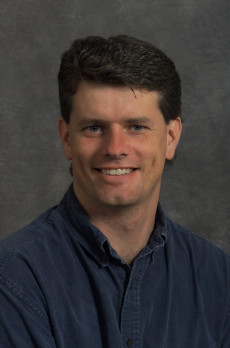CCSE's Marc Day Awarded NASA Allocation for Combustion Research
April 18, 2007
Research to quantify the formation of pollutants during natural gas combustion has received 1.5 million computing hours from NASA. Led by Marc Day in CRD’s Center for Computational Sciences and Engineering, the project, “Flames Dynamics and Emission Chemistry in High-Pressure Industrial Burners,” was one of the four awarded by NASA last month under its National Leadership Computing System initiative.
The initiative sets out to support computationally intensive projects that advance a wide-range of national interests. The initiative additionally includes projects geared to improving aerospace vehicle design and climate change predictions.
Day will compute on the Columbia system (2,048-processor SGI Altix) at the NASA Advanced Supercomputing (NAS) facility, located at the AMES Research Center in Moffett Field, California.
“This is the second year now we’ve had the opportunity to access the Columbia computing resources,” Day said. “In the first year, we created several terabytes of very interesting data, giving us and our experimental colleagues beautiful and complicated pictures of turbulent flame dynamics. This year, the calculations have stepped up another notch and now have a distinct practical purpose.”
“The new project is an even greater challenge in terms of creating and then ingesting the huge simulation data sets, and developing new tools that help us to complete a picture of what’s going on in these complex systems,” he added.
Day and his fellow researchers plan to simulate natural gas combustion in power-generation turbines in order to determine the mechanisms that modulate the production of pollutants, especially nitrogen oxides.
Nitrogen oxides contribute to the formation of acid rain, and can also cause serious respiratory problems. Understanding the mechanisms that produce nitrogen oxide in turbulent flames could lead to better designs of turbine combustors and ultimately to cleaner methods of producing electricity.
Simulation of these systems has the potential to provide a unique and critical role, since these high-pressure scenarios operate in an environment that is hostile to a wide range of traditional experimental diagnostics (problems include reduced optical access, laser field attenuation, signal quenching, pressure-induced flame thinning, etc).
The development of the simulation code LMC has been a key technology enabling Day’s research into premixed burner. LMC implements a complex but highly efficient approach to advancing the equations of motion for a reacting gas in the special but very important regime, where convection is slow relative to the speed of acoustic waves.
Combining the large time steps afforded through these so-called low Mach number approaches with a dynamically adaptive grid scheme, LMC is uniquely capable of marshalling thousands of distributed memory processors to simulate turbulent combustion systems. It is the only tool presently able to do so at the spatial and temporal scales observable in laboratory experiments.
Day plans to carry out a number of studies to investigate the combined roles of injector swirl and fuel-air mixtures on pollutant production. Highly swirled injection, the baseline approach, results in a strong recirculation of heat that robustly stabilizes natural gas flames at the premixed fuel nozzle. But these recirculation zones dramatically increase the amount of time the exhaust stays in the heated chamber environment. Longer residence times in the heated exhaust streams lead to unacceptably high pollutant emissions.
Low-swirl injectors (LSI) are a new burner design developed by Robert Cheng of LBNL’s Environmental Energy Technologies Division. LSI devices are carefully designed to stabilize premixed flames aerodynamically without creating a large recirculation zone. Cheng has put his concept to test at in a prototypical industrial furnace as a drop-in replacement to the “SoLoNOx” commercial turbine injector configuration. And while the burner has performed admirably, the high-pressure rig allows only a limited set of diagnostics, and prevents collection of sufficiently detailed data necessary for further refinements in the designs of the low-swirl injector device.
Day’s proposed simulations will provide unprecedented detail about the flame stability and emissions characteristics of this class of swirl burners. However, the real hope is that the mountains of data will help to shed light on the fundamental processes responsible for pollutant formation, how these processes are affected by pressure and turbulence and, in turn, how the flame and turbulence can be controlled to optimize the overall performance.
Modern combustion research has made a significant impact in the reduction of pollutants produced by industrial combustion applications. Over the last three decades, nitrogen oxide emission standards have been successfully reduced to less than 25 ppm, due in a large part to the implementation of advanced combustion concepts. Cheng’s low swirl technology has the potential to further reduce these levels to just 5 ppm.Given the degree to which U.S. industry remains invested in combustion-based energy technology, understanding and optimizing the performance of these ultra-low pollution combustion devices will go a long way towards protecting the global environment.
About Berkeley Lab
Founded in 1931 on the belief that the biggest scientific challenges are best addressed by teams, Lawrence Berkeley National Laboratory and its scientists have been recognized with 16 Nobel Prizes. Today, Berkeley Lab researchers develop sustainable energy and environmental solutions, create useful new materials, advance the frontiers of computing, and probe the mysteries of life, matter, and the universe. Scientists from around the world rely on the Lab’s facilities for their own discovery science. Berkeley Lab is a multiprogram national laboratory, managed by the University of California for the U.S. Department of Energy’s Office of Science.
DOE’s Office of Science is the single largest supporter of basic research in the physical sciences in the United States, and is working to address some of the most pressing challenges of our time. For more information, please visit energy.gov/science.










